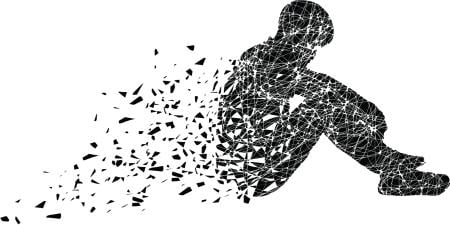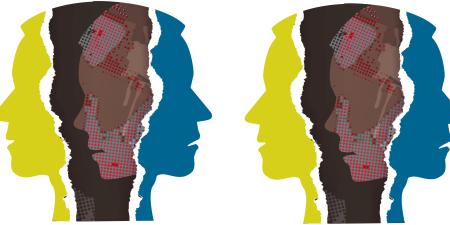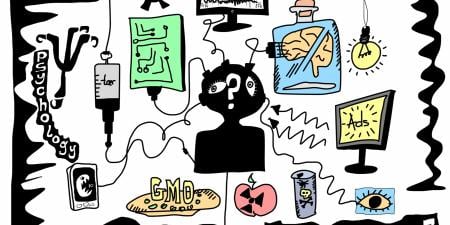Abstract
Addiction is a complex phenomenon characterized by a loss of control and compulsive, habitual behavior. Since there is no single, specific cause for addiction, there is no single, standard treatment for it. A variety of approaches are used, including counseling, psychotherapy, medications, and mutual help groups (MHG). The best known and most widely available approach to addiction is 12-step (TS) programs of recovery, a variety of MHG. These have been lauded as lifesaving by some and criticized by others. We argue that TS programs are an appropriate mode of help for those seeking to quit an addiction but should not be the only approach considered.
Addiction
Addiction is a complex phenomenon influenced by psychosocial, environmental, neurological, and genetic factors and characterized by loss of control and compulsive, habitual behavior [1]. While sometimes used interchangeably with “chemical dependency,” the term “addiction” is used here to refer to any compulsive habit, including use of substances that produce dependency (e.g., alcohol), use of substances that do not produce dependency (e.g., marijuana), and compulsive habits unrelated to substances (e.g., gambling).
Since there is no single, specific cause for addiction, there is no single, standard treatment for it. A variety of psychosocial treatments are used, including counseling, psychotherapy, and mutual help groups (MHG) [2]. Medication might be helpful, even essential, in some cases. These treatments might be used in combination or sequentially and in a range of different settings. None, however, promises even a probable cure for a particular person.
The best known and most widely available approach to addiction is 12-step (TS) programs of recovery, a variety of MHG. These have been lauded as lifesaving by some and criticized by others [3]. We argue that TS programs are an appropriate mode of help for those seeking to quit an addiction but should not be the only approach considered. Persistence in the chosen modality and solid, healthy relationships with the people facilitating recovery could be more important than the modality itself [4-6].
Twelve-Step Programs of Recovery
TS philosophy. The original TS program was developed by Alcoholics Anonymous® (AA)®. AA was founded in 1935 by physician Bob Smith and businessman Bill Wilson, who were both addicted to alcohol and looking to maintain sobriety. The 12 steps used in the program appeared in print in 1939, when Wilson and Smith published Alcoholics Anonymous: The Story of How More than One Hundred Men Have Recovered from Alcoholism [7]. Since then, other TS groups using similar principles have emerged to address other addictions, including Gamblers Anonymous® (GA®), Overeaters Anonymous® (OA®), Narcotics Anonymous® (NA®), and others.
The official AA position is that alcohol addiction is a progressive condition [8], characterized by “powerless[ness] over alcohol” [9]. On this view, alcoholism cannot be “cured”—an alcoholic cannot expect to be able to drink moderately—but the illness can be arrested by abstaining from drinking alcohol [8]. The essence of the method is that members help one another stay sober by “working the steps.” The steps are simple and can be summarized as follows [10]: (a) acknowledgement that one has become “powerless” to control one’s drinking; (b) trust that “a Power greater than ourselves” [11] can help one stay sober; and (c) acceptance of responsibility for one’s behavior, including admission of character defects, making amends for past mistakes, and striving to be honest with self and others. Thus, on this view, alcoholics are powerless over alcohol but do have power to abstain, with help, one day at a time. While AA’s position is clear that alcoholism is not a moral failing, it is equally clear that recovery depends on alcoholics’ taking responsibility for living with their condition, much like asthmatics must take responsibility for maintaining treatment of their illness.
Although not a treatment per se [12], TS groups do have something important to offer people who are attempting to quit an addiction: they provide a social network that supports recovery; they emphasize both the powerfully compulsive nature of addiction and the importance of harnessing an individual addict’s personal responsibility; there are no dues or fees for members; there are no requirements, pledges, or oaths to become a member; meetings are available in many places and at many times of the day and night; and they are compatible with other measures.
Do 12-Step Groups “Work”? Ferri, Amato, and Davoli’s conclusion in a 2006 meta-analysis published in the Cochrane Review [13] has been widely quoted (see e.g., [14]): “No experimental studies unequivocally demonstrated the effectiveness of AA or [Twelve-Step Facilitation] TSF approaches for reducing alcohol dependence or problems” [13]. Less widely quoted is the earlier discussion in which the authors say “there is no conclusive evidence to show that AA can help to achieve abstinence, nor is there any conclusive evidence to show that it cannot” [13]. To us, it appeared there was little difference among the treatments analyzed.
Several studies do support some efficacy of TS programs of recovery [15-19]. AA participation is associated with fewer drinks and more abstinent days [15-17], and recent studies show that AA attendance improves sobriety even while controlling for self-selection bias [18]. While these studies do not show unequivocal evidence of success—and are not evidence of sufficient effectiveness to recommend AA/TS programs for everyone—they do support inclusion of TS in the set of appropriate interventions.
Before turning to criticisms of TS, it is worth noting that TS groups (e.g., AA, GA, OA) are distinct from both professionally led treatment programs(inpatient or outpatient) that use TS as their foundation and the therapeutic technique grounded in the TS principles known as TSF [20].
Critiques of TS. Several features of TS programs make them a poor fit for some people who are seeking recovery. To begin with, some who eschew TS programs might find the emphasis on spirituality off-putting. AA maintains that the “Power greater than ourselves” can be construed as a non-theistic power, such as the power of the community [11], but this rings hollow for some recovery seekers. Additionally, TS programs promote the goal of abstinence, but moderation is a better goal for some people. Some people find that the emphasis on powerlessness erodes their confidence, and others dislike the group format inherent in TS. And some are bothered by the inconsistent, somewhat sloppy reasoning that runs through the TS philosophy. For example, AA’s position that alcoholism is an illness or malady (akin to an allergy) [7] seems out of step with its view that it’s a spiritual problem; and the claim that alcoholism is not a moral failing seems at odds with phrases like make “a searching and fearless moral inventory of ourselves” [21] and “remove all defects of character” [22] found in Step 4 and Step 6.
Perhaps the most damning criticism of AA and other TS programs concerns the variability in adherence to core tenets from group to group. Since it is nonprofessional by design, quality control measures are minimal, and there is no way to ensure that every group adheres consistently to all of its principles. Thus, some criticisms of TS refer to beliefs and attitudes that can be found in some individual TS groups or members but that are inconsistent with the official position of AA. These include that it is a religious (specifically Christian) organization; that it shames addicts as being morally flawed [23]; that members are not allowed to use medications to support sobriety [24]; and that AA claims that it is the only way someone can get sober. Of course, variability of beliefs and attitudes among members of any organization is not uncommon and can lead to assumptions and misunderstandings about other members or the organization as a whole.
A related point is that some critiques of TS do not maintain a clear distinction between TS groups and rehabilitation programs and facilities that use TS groups, principles, or TSF [3, 25]. These criticisms take aim at the enormous expense of many inpatient rehabilitation units and the marketing used to encourage their use. They note that while hospitalization might provide a pleasant respite for those beginning recovery, the stressors of real life are waiting on the other side of discharge, which might account for these programs’ low rates of success despite the huge investment of money and time involved. It’s important to note that these are sound critiques of the rehabilitation industry, but not of TS programs as such. Moreover, some TS critics acknowledge that TS programs do help many people achieve recovery, but they are distressed about the lack of knowledge of and support for other addiction treatment modalities [3, 25]. Creating awareness of all the interventions that can help facilitate recovery is important, although the antagonistic tone of the addiction debate in popular media can, unfortunately, obscure points of agreement.
In sum, TS programs of recovery are a respectable modality to recommend to those seeking help with addiction; however, the effect is not sizeable enough for clinicians to insist on TS for everyone seeking treatment for addiction.
Other Addiction Treatments
Psychosocial approaches. There are many interventions available that address the emotional, social, and spiritual dimensions of addiction. Psychotherapeutic approaches, including cognitive behavioral therapy (CBT), aim at helping addicts understand why they have adopted addictive behavior and encourage self-reflection and self-efficacy. Motivational Interviewing (MI) and Motivation Enhancement Therapy (MET) aim at enhancing the addict’s intrinsic motivation to change. Family-based approaches, such as the Community Reinforcement Approach (CRA) and Community Reinforcement and Family Therapy (CRAFT), encourage recovery by changing the addict’s social environment. Other MHGs for addiction include SMART Recovery® (Self-Management and Recovery Training), Moderation ManagementTM, and Celebrate Recovery®. These differ from TS groups in their philosophy and/or goal of recovery and are a better fit for some people. Brief interventions use a variety of approaches, often in emergency or one-time settings. Inpatient and intensive outpatient (IOP) programs also use different approaches, which may or may not include TS groups, TS principles, or TSF [26].
It should be noted that psychotherapeutic interventions are vulnerable to one of the problems that plague TS programs: variability. Even among licensed therapists, there is variability in skill and expertise. Additionally, an important component in the success of a therapeutic encounter is the “fit” or rapport between client and therapist [27-29]. Thus, if any intervention fails—or succeeds—it might be hard to say exactly why.
Medication. Several kinds of pharmacotherapy are available to treat addiction, including replacement therapies, such as methadone and nicotine patches, and others that block the rewarding effects of alcohol and opioids, such as acamprosate and naltrexone; we will confine ourselves here to the latter. While the evidence suggests that these medications can contribute to recovery, it does not provide strong support for preferring one treatment over another or for preferring pharmacotherapy over behavior therapy [27, 30].
Combining modalities. The COMBINE study randomized 1,383 alcohol-dependent patients to 9 groups of pharmacologic and behavioral interventions. All received medical management (a type of addiction counseling, delivered by a health care professional) and differing combinations of naltrexone, acamprosate, placebo, and/or behavioral interventions. A reduction in drinking was found in all groups, although patients who received medical management and either naltrexone or psychosocial therapy had the highest percentage of abstinent days [30].
We think the COMBINE study provides good support for considering a multifaceted approach to therapy [31], since patients receiving all combinations of psychosocial and pharmacological therapies showed improvement. It also opens the door to considering new lines of research. Notably, patients in the “medical management plus placebo” arm did as well as patients in the “active” treatment arms. Why? Common factors might be at least part of the answer. Briefly, common factor theory holds that all therapies share common factors, such as the client-therapist relationship, and that these common factors account for as much or more of the therapeutic effect as the specific technique used in therapy [28, 29].
Framing the Issue
Relapse rates within six months of addiction treatment are estimated to be at least 40-60 percent in the general population [32], and no treatment has been shown to be far superior to another for a particular person [33-36]. These findings may lead some to question whether any treatment for addiction can be recommended. However, if we compare relapse rates for drug addiction to those for chronic medical illnesses, the results are not so gloomy. Figure 1, reproduced from a National Institute of Drug Abuse (NIDA) report [36], compares addiction relapse rates to relapse rates among patients with diabetes, asthma, and hypertension.
Figure 1. Comparison of relapse rates between drug addiction and other chronic illnesses [36].
Although whether to consider addiction a disease (as NIDA does) is beyond the scope of this paper, we do suggest that the addiction treatment paradigm of an acute disorder with a cure should be reframed as a chronic and relapsing condition needing continued care [31]. Similarly, perhaps a change in the focus of addiction research from a model that seems to favor named treatments in prescribed doses, whether pharmacological or psychosocial, to a model that looks at therapist and treatment delivery factors is needed [37, 38]. Moreover, we suggest that anticipating relapse and considering relapses an opportunity to think about different interventions might lead to decreased stigma and overall better outcomes.
Navigating an Evidence-Poor Zone
As we can see, then, research on the efficacy of approaches to addiction recovery is not conclusive; we are in an evidence-poor zone. Although we may wish for randomized controlled trials that conclusively demonstrate the effectiveness of each modality for each type of addiction, such studies are few. The many variables among addicts, treatment modalities, and practitioners make reliable generalizations difficult. Different treatment goals—abstinence versus harm reduction—and differing attitudes toward relapse further complicate whether to conclude that an intervention “works.” There is also the general difficulty of using quantitative methods with qualitative phenomena. Moreover, addiction does not appear to be a natural kind—that is, addictions don’t appear to share a common set of physiological or psychological mechanisms [39]. What they do seem to have in common is the lived human experience of compulsion. This is not to say that research is useless; studies of different interventions still yield useful information. But we do not expect precise and certain answers to emerge from research, at least not any time soon.
How, then, can a physician proceed ethically in an evidence-poor zone? In part, by recognizing both the importance and the limits of evidence-based medicine. Current data suggest that TS programs are quite appropriate to suggest for many who are struggling with addiction, although other available approaches should be suggested as well. Don’t insist on anything in particular, but do insist on something, and it should be something to which the patient can commit. People who are not comfortable with TS are less likely to stick with it. Encourage other modalities and be vigilant for opportunities to enhance self-efficacy and internal motivation. In making recommendations, consider the person’s goal for recovery (abstinence or moderation) and the financial and social costs of the modality relative to the likelihood of success [40]. Facilitate plans for when (not if) relapse occurs. Encourage the relationships and the ancillary habits that support recovery. Finally, advocate for accessible resources that treat addiction as a chronic, relapsing condition with psychosocial, environmental, neurological, and genetic dimensions.
References
- Savage SR, Joranson DE, Covington EC, Schnoll SH, Heit HA, Gilson AM. Definitions related to the medical use of opioids. J Pain Symptom Manage. 2003;26(1):655-667.
-
MHGs are also called self-help groups, but that term lacks emphasis on the essential feature of one person helping another.
-
Dodes L, Dodes Z. The Sober Truth: Debunking the Bad Science Behind 12-Step Programs and the Rehab Industry. Boston, MA: Beacon Press 2014.
- Moos RH, Moos BS. Sixteen-year changes and stable remission among treated and untreated individuals with alcohol use disorders. Drug Alcohol Depend. 2005;80(3):337-347.
-
Bergmark A. On treatment mechanisms—what can we learn from the COMBINE study? Addiction. 2008;103(5):703-705.
- Crits-Christoph P, Mintz J. Implications of therapist effects for the design and analysis of comparative studies of psychotherapies. J Consult Clin Psychol. 1991;59(1):20-26.
-
Smith RH, Wilson B; Alcoholics Anonymous. Alcoholics Anonymous: The Story of How More than One Hundred Men Have Recovered from Alcoholism. New York, NY: Works Publishing; 1939.
-
Alcoholics Anonymous. Letter to anyone new to A.A. http://www.aa.org/pages/en_US/letter-to-anyone-new-to-aa. Accessed April 26, 2016.
-
Alcoholics Anonymous. Step one. http://www.aa.org/assets/en_US/en_step1.pdf. Accessed April 26, 2016.
-
Alcoholics Anonymous. Twelve steps. http://www.aa.org/pages/en_US/twelve-steps-and-twelve-traditions. Accessed April 26, 2016.
-
Alcoholics Anonymous. Step two. http://www.aa.org/assets/en_US/en_step2.pdf. Accessed April 26, 2016.
-
White WL, Kurtz E. Twelve defining moments in the history of alcoholics anonymous. Recent Dev Alcohol. 2008;18:37-57.
-
Ferri M, Amato L, Davoli M. Alcoholics Anonymous and other 12-step programmes for alcohol dependence. Cochrane Database Syst Rev. 2006;(3):CD005032.
-
Frakt A. What is known about the effectiveness of AA? Incidental Economist. December 20, 2010. http://theincidentaleconomist.com/wordpress/what-is-known-about-the-effectiveness-of-aa/. Accessed May 2, 2016.
- Walitzer KS, Dermen KH, Barrick C. Facilitating involvement in Alcoholics Anonymous during out-patient treatment: a randomized clinical trial. Addiction. 2009;104(3):391-401.
- Witbrodt J, Ye Y, Bond J, Chi F, Weisner C, Mertens J. Alcohol and drug treatment involvement, 12-step attendance and abstinence: 9-year cross-lagged analysis of adults in an integrated health plan. J Subst Abuse Treat. 2014;46(4):412-419.
- Moos RH, Moos BS. Participation in treatment and Alcoholics Anonymous: a 16-year follow-up of initially untreated individuals. J Clin Psychol. 2006;62(6):735-750.
- Humphreys K, Blodgett JC, Wagner TH. Estimating the efficacy of Alcoholics Anonymous without self-selection bias: an instrumental variables re-analysis of randomized clinical trials. Alcohol Clin Exp Res. 2014;38(11):2688-2694.
- Kaskutas LA. Alcoholics Anonymous effectiveness: faith meets science. J Addict Dis. 2009;28(2):145-157.
-
TSF is not officially related to or sanctioned by AA. It is available as a manual for standardized use by addiction treatment facilitators with a focus on abstinence as a treatment goal. Participation in AA meetings and other official AA activities (such as service and AA social events) is encouraged as a means to that end. See Nowinski J, Baker S, Carroll K. Twelve Step Facilitation Therapy Manual: A Clinical Research Guide for Therapists Treating Individuals with Alcohol Abuse and Dependence. Bethesda, MD: National Institute on Alcohol Abuse and Alcoholism; 1991. Project MATCH Monograph Series; vol 1. NIH publication 94-3722.
-
Alcoholics Anonymous. Step four. http://www.aa.org/assets/en_US/en_step4.pdf. Accessed May 2, 2016.
-
Alcoholics Anonymous. Step six. http://www.aa.org/assets/en_US/en_step6.pdf. Accessed May 2, 2016.
-
Peele S. American addiction treatment is shame-based. Psychology Today. January 2, 2015. https://www.psychologytoday.com/blog/addiction-in-society/201501/american-addiction-treatment-is-shame-based. Accessed May 2, 2016.
-
Baxter LE. Twelve step recovery and medication assisted therapies. June 12, 2014. http://www.asam.org/magazine/read/article/2014/06/12/twelve-step-recovery-and-medication-assisted-therapies. Accessed May 2, 2016.
-
Glaser G. The irrationality of Alcoholics Anonymous. The Atlantic. April 2015. http://theatlantic.com/magazine/archive/2015/04. Accessed May 2, 2016.
-
O’Donnell A, Wallace P, Kaner E. From efficacy to effectiveness and beyond: what next for brief interventions in primary care? Front Psychiatry. 2014;5:113. http://journal.frontiersin.org/article/10.3389/fpsyt.2014.00113/full. Accessed May 2, 2016.
- Ernst DB, Pettinati HM, Weiss RD, Donovan DM, Longabaugh R. An intervention for treating alcohol dependence: relating elements of medical management to patient outcomes with implications for primary care. Ann Fam Med. 2008;6(5):435-440.
-
Imel ZE; Wampold BE. The importance of treatment and the science of common factors in psychotherapy. In: Brown SD, Lent RW, eds. Handbook of Counseling Psychology. 4th ed. Hoboken, NJ: John Wiley & Sons; 2008:249-267.
- Messer SB, Wampold BE. Let’s face facts: common factors are more potent than specific therapy ingredients. Clin Psychol Sci Pract. 2002;9(1):21-25.
- Anton RF, O’Malley SS, Ciraulo DA, et.al. COMBINE Study Research Group. Combined pharmacotherapies and behavioral interventions for alcohol dependence: the COMBINE study: a randomized controlled trial. JAMA. 2006;295(17):2003-2017.
-
Lenaerts E, Matheï C, Matthys F, et al. Continuing care for patients with alcohol use disorders: a systematic review. Drug Alcohol Depend. 2014;135:9-21.
-
Hubbard RL, Flynn PM, Craddock G, Fletcher B. Relapse after drug abuse treatment. In: Tims F, Leukfield C, Platt J, eds. Relapse and Recovery in Addictions. New Haven, CT: Yale University Press; 2001:109-121.
-
McLellan AT, Skipper GS, Campbell M, DuPont RL. Five year outcomes in a cohort of physicians treated for substance use disorders in the United States. BMJ. 2008;337:a2038. http://www.bmj.com/content/337/bmj.a2038.long. Accessed May 2, 2016.
- McLellan AT, Lewis DC, O’Brien CP, Kleber HD. Drug dependence, a chronic medical illness: implications for treatment, insurance, and outcomes evaluation. JAMA. 2000;284(13):1689-1695.
-
Matching alcoholism treatments to client heterogeneity: Project MATCH posttreatment drinking outcomes. J Stud Alcohol. 1997;58(1):7-29.
-
National Institute on Drug Abuse. Drugs, Brains, and Behavior: The Science of Addiction. https://www.drugabuse.gov/sites/default/files/sciofaddiction.pdf. Published April 2007; revised August 2010:26. NIH publication 10-5605.
- Orford J. Joining the queue of dissenters. Addiction. 2008;103(5):706-707.
- Moos RH. Theory-based active ingredients of effective treatments for substance use disorders. Drug Alcohol Depend. 2007;88(2-3):109-121.
-
Pober JM. Addiction is not a natural kind. Front Psychiatry. 2013;4(123). http://journal.frontiersin.org/article/10.3389/fpsyt.2013.00123/full. Accessed May 2, 2016.
-
For example, if a stay at a rehabilitation facility is going to drain a family’s resources, the outcome would have to be certain, positive, and profound to be an ethical recommendation.



